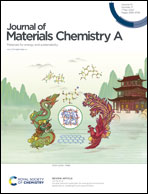A mild, versatile and time-saving interfacial gelation blackening strategy for fabricating high-quality 3D porous solar steam evaporators†
Abstract
Fabricating high-performance solar steam evaporators using 3D porous substances with natural advantages in light absorption, water transmission and thermal insulation has gradually become a research hotspot. However, developing a simplified, time-saving and material-independent surface blackening strategy is critical but still rare. Herein, we propose a novel interfacial gelation blackening strategy based on sodium alginate (SA), tannic acid (TA) and Fe3+ to transform various different 3D porous materials (organic melamine-formaldehyde sponge, inorganic diatom ooze, biomass wood and metal nickel foam) into high-quality solar steam evaporators within few minutes. The as-fabricated black materials can achieve a high water evaporation rate above 2.00 kg m−2 h−1, which is much higher than related reports. Considering the universality, simplicity and scalability of the surface blackening method, as well as the effective purification of the modified materials toward simulated seawater, high-concentration brine, dye wastewater, and heavy metal wastewater, this proposal demonstrates the great scientific significance to promote the actual use of high-quality solar steam evaporators.



 Please wait while we load your content...
Please wait while we load your content...